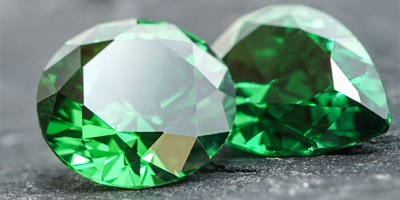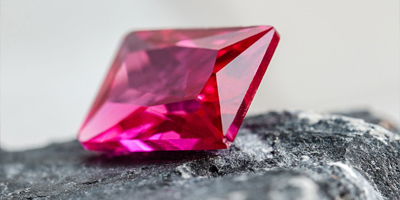Learning About Emeralds
Emeralds: Composition, Formation, and Origins
Emeralds belong to the beryl family, which also includes aquamarine and morganite. While emeralds are defined by their intense green color, they can exhibit a range of green shades, from light to deep forest green. The green hue is attributed to trace amounts of chromium or vanadium in the stone’s composition.
Chemical Composition and Crystal Structure
Emeralds are composed of beryllium aluminum silicate (Be₃Al₂Si₆O₁₈), and their characteristic green color is caused by the presence of chromium or vanadium. The exact shade of green depends on the specific concentration of these trace elements. Emeralds have a hexagonal crystal system and form in long prismatic crystals. However, due to their formation in extreme conditions, emeralds often contain inclusions, which are internal features known as “jardin” (French for garden). These inclusions can affect the clarity but also serve as identifying characteristics for natural emeralds.
Despite their stunning beauty, emeralds are softer than sapphires, with a rating of 7.5 to 8 on the Mohs scale, which makes them more prone to scratching and chipping. As a result, they are often treated to enhance their durability and appearance.
Formation of Emeralds
Emeralds form in hydrothermal veins deep within the Earth’s crust, where beryllium comes into contact with chromium or vanadium-rich solutions. These conditions occur under intense pressure and moderate temperatures. The formation process often results in the stone’s signature inclusions. Emeralds are found in host rocks like schist, granite, and limestone, with tectonic activity playing a major role in their formation.
Over millions of years, the gemstones are transported closer to the Earth’s surface, where they can be mined.
Where Are Emeralds Found?

Emeralds are sourced from a few key regions, with each location producing stones that are renowned for specific qualities:
Colombia: Colombian emeralds are regarded as the finest and most sought after in the world. They are typically a deep, lush green with excellent saturation and minimal yellow or blue secondary tones. Mines like Muzo and Chivor are renowned for their exceptional quality.
Zambia: Zambian emeralds are known for their slightly darker, bluish-green tones. Though not as vividly green as Colombian emeralds, Zambian stones are highly prized for their clarity and affordability.
Brazil: Brazilian emeralds often display lighter, more transparent green hues and have fewer inclusions. These stones are often more affordable but still beautiful.
Other sources include Afghanistan, Ethiopia, and Zimbabwe, each offering emeralds with unique characteristics.
Different Colors of Emeralds
Emeralds are highly valued for their captivating green color, but the exact shade can vary widely depending on their geographic origin and unique chemical composition. While emeralds from different regions may share similar characteristics, each source can impart distinct qualities that affect the stone’s overall appearance and desirability. Here’s a closer look at some of the most well-known varieties.
Colombian Emeralds:
Colombian emeralds are considered the pinnacle of the emerald world, prized for their vibrant and intense pure green hue. They often have a slightly warm undertone, which enhances the richness and depth of the color. The saturation of these emeralds is typically very high, with minimal secondary hues, making them some of the most valuable gemstones on the market. The color can range from deep forest green to a bright, vivid green that seems to glow from within. The region’s unique geological conditions are largely responsible for this exceptional color quality, which is why Colombian emeralds are often viewed as the gold standard.

Zambian Emeralds:
Emeralds from Zambia often exhibit a slightly cooler green tone, with noticeable bluish-green hues. This cooler undertone, while still highly valued, tends to give the emeralds a more subdued appearance compared to their Colombian counterparts. However, Zambian emeralds are often more affordable, which makes them a popular choice for those seeking quality emeralds without the high price tag. Additionally, these emeralds are known for their good clarity and fewer inclusions, which can enhance their appeal despite the difference in hue. Their unique combination of color and clarity has earned them a strong reputation in the gemstone market.

Brazilian Emeralds:
Brazilian emeralds are known for their lighter, more transparent green color, often accompanied by fewer inclusions compared to emeralds from other regions. While the green may not be as deep or intense as Colombian or Zambian emeralds, the transparency of Brazilian stones can lend them a more delicate, ethereal appearance. These stones tend to have a cleaner look, which can make them particularly desirable for those who prefer a less saturated but more flawless emerald. Their lighter hue, combined with a more glassy, transparent texture, offers a unique appeal, though they are generally considered less valuable than the more richly colored emeralds from Colombia or Zambia.

Emeralds' value is heavily influenced by their color. Several factors contribute to how color impacts the stone's worth
Hue: Emeralds should ideally have a pure green hue. Secondary hues like blue or yellow can affect the value, with blueish-green being more acceptable than yellowish-green.
Saturation: High-quality emeralds have a rich, vibrant green with excellent saturation. Stones with lower saturation may appear washed out or less valuable.
Tone: The ideal tone for emeralds is medium to medium-dark, meaning the stone should have a deep, rich color without being too light or overly dark.
Color Consistency: Even color distribution without zoning or patches significantly raises the emerald’s value.
Emerald Value: Natural, Treated, and Synthetic Comparisons
Untreated Emeralds: These are the most valuable due to their natural, unaltered state. They are extremely rare, especially in larger sizes.
Treated Emeralds: Most emeralds are treated with oils (commonly cedar oil) to fill fractures and improve clarity. This treatment is widely accepted, but the degree of treatment can impact value.
Synthetic Emeralds: Created in a laboratory, synthetic emeralds possess the same physical and chemical properties as natural emeralds but lack the rarity and history of natural stones, making them less valuable.
Emerald Treatments
Oil Treatments
Purpose: To mask fractures and enhance clarity. It also helps to reinforce the stone’s structural integrity.
Types of Oil: While cedar oil is the most commonly used, other oils, such as palm or synthetic oils, may be applied. Cedar oil is preferred due to its refractive index, which closely matches that of emeralds, making the treatment less detectable.
Stability: Oil treatments are not permanent. Over time, oils can dry out or leak, especially when exposed to high heat, direct sunlight, or certain cleaning methods like ultrasonic cleaners. This may necessitate periodic re-treatment to maintain the stone’s appearance.
Impact on Value: Emeralds that have undergone minor oil treatment retain most of their value, but those with moderate or significant treatments are typically valued lower. In rare cases, some emeralds may be untreated, which significantly enhances their market value.
Detection of Oil Treatment
Specialized gemological labs use magnification, UV light, and immersion techniques to detect oil treatments. Reputable labs, such as the Gemological Institute of America (GIA) and the American Gemological Laboratories (AGL), provide treatment disclosures on emerald certifications, indicating the extent of the treatment: None, Minor, Moderate, or Significant.
Resin and Polymer Treatment
Some emeralds are treated with synthetic resins or polymers instead of traditional oils. This process involves injecting a resin into surface-reaching fractures to fill them and provide additional structural support.
Purpose: To improve clarity and durability in emeralds with more severe fractures than those treated with oil.
Types of Resins: Epoxy resins or polymer-based fillers are used. Unlike oil, these substances harden once applied, offering more permanent fracture filling.
Stability: Resin treatments are more durable than oil treatments but are less desirable because they are harder to detect and reverse. Some resins may discolor over time, altering the stone’s appearance.
Impact on Value: Emeralds treated with resins are generally valued lower than those treated with oil. Resin-treated stones may be considered less authentic by collectors and connoisseurs, and some markets may be hesitant to accept them.
Detection of Resin Treatment
Resin treatments can often be detected through advanced lab techniques like infrared spectroscopy and UV fluorescence. A gemologist can also spot resin treatments with magnification, as resin tends to leave a slightly different sheen or luster compared to oil-treated emeralds.
Other Treatments and Experimental Enhancements
Surface Coating: In rare cases, emeralds may be coated with a thin film to enhance color or brilliance. These coatings can wear off over time and reduce the stone’s value if detected.
Color Dyes: Some emeralds may be treated with green dye to enhance their color, though this is considered a lower-quality enhancement and is generally frowned upon in the market. Dyeing can severely impact an emerald’s value and desirability.
Treatment Grading and Disclosure
When purchasing emeralds, it’s important to know the extent of treatment, as it directly affects the gem’s market value and longevity. Reputable laboratories grade treatments as follows:
None: The emerald has not undergone any treatments, making it highly valuable and rare.
Minor: Only a small amount of oil or resin is used to fill fractures. These emeralds are considered of high quality and retain most of their value.
Moderate: A moderate amount of treatment is applied, often visible under magnification. While still beautiful, the emerald’s value is lower than that of untreated or minimally treated stones.
Significant: Extensive treatment has been performed, typically involving larger fractures and more visible treatments. These emeralds are usually more affordable but are considered less desirable by collectors.
Emerald Cuts and Shapes
The cut of an emerald is crucial in showcasing its beauty, as a well-executed cut can enhance the stone’s color and hide inclusions. Some common cuts for emeralds include:
Emerald Cut: The most iconic shape for emeralds, this rectangular step-cut emphasizes the stone’s color and clarity, creating a sophisticated look.
Oval Cut: This cut showcases the emerald’s green hue while giving the stone a larger appearance.
Cushion Cut: This square or rectangular cut with rounded corners softens the stone’s appearance and enhances color.
Key Questions to Consider Before Buying an Emerald
Color: The most important factor. Ask for a summary of the emerald’s hue, saturation, and tone. Inquire about any secondary hues that could affect its value.
Clarity: Most emeralds contain inclusions, so it’s important to ask if they are eye-visible and if they affect the stone’s durability.
Cut: Ensure the stone is well-cut to enhance its color and minimize visible inclusions.
Treatment: Ask if the emerald has undergone oil or resin treatment and to what degree.
Origin: Emeralds from Colombia are typically more valuable, but Zambian and Brazilian stones can offer excellent alternatives at lower prices.
Certification: Always request a certification from a reputable lab (such as GIA or AGL) to ensure the emerald’s authenticity and treatments.
Key Pages: Create & Customize Jewelry
Key Pages: Diamond Jewley From the Atelier
Essential Diamond & Jewelry Education
Important Links: Support & Policies
MyAntwerpDiamonds.com /
Some email responses from us may be filtered as spam or blocked altogether. To ensure you receive our emails, please provide your telephone or WhatsApp number for verification.



